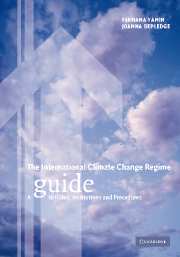Book contents
- Frontmatter
- Contents
- List of figures
- List of tables
- List of boxes
- Foreword by Joke Waller Hunter, Executive Secretary, FCCC
- Preface and acknowledgements
- List of abbreviations
- 1 Introduction
- 2 Overview
- 3 Regime participants
- 4 Objective and principles
- 5 Mitigation commitments
- 6 Flexibility mechanisms
- 7 Research, systematic observation, education, training and public awareness
- 8 Adaptation
- 9 Impacts of response measures
- 10 Finance, technology and capacity-building
- 11 Reporting and review
- 12 Compliance
- 13 Institutions
- 14 The negotiation process
- 15 Scientific and technical input
- 16 Administering the regime
- 17 Linkages
- 18 Evolution of the regime
- 19 Conclusion: taking stock and moving forward
- Appendix I List of Parties, their groups and key statistics
- Appendix II Annex I Party fact sheets: emissions, targets and projections for Annex I Parties and groupings
- Appendix III Table of Articles, issues and COP Decisions
- Bibliography
- Index
10 - Finance, technology and capacity-building
Published online by Cambridge University Press: 16 July 2009
- Frontmatter
- Contents
- List of figures
- List of tables
- List of boxes
- Foreword by Joke Waller Hunter, Executive Secretary, FCCC
- Preface and acknowledgements
- List of abbreviations
- 1 Introduction
- 2 Overview
- 3 Regime participants
- 4 Objective and principles
- 5 Mitigation commitments
- 6 Flexibility mechanisms
- 7 Research, systematic observation, education, training and public awareness
- 8 Adaptation
- 9 Impacts of response measures
- 10 Finance, technology and capacity-building
- 11 Reporting and review
- 12 Compliance
- 13 Institutions
- 14 The negotiation process
- 15 Scientific and technical input
- 16 Administering the regime
- 17 Linkages
- 18 Evolution of the regime
- 19 Conclusion: taking stock and moving forward
- Appendix I List of Parties, their groups and key statistics
- Appendix II Annex I Party fact sheets: emissions, targets and projections for Annex I Parties and groupings
- Appendix III Table of Articles, issues and COP Decisions
- Bibliography
- Index
Summary
Introduction
Countries' contribution to climate change and their capacity to prevent and cope with its consequences vary enormously. The Convention and the Protocol therefore mandate financial and technological transfers from Parties with more resources to those less well endowed and more vulnerable. Limited human and institutional capacity can also cause bottlenecks in policy formation and implementation. Accordingly, in recent years, the COP has adopted a number of decisions to strengthen capacity-building in developing countries as well as EITs.
This chapter describes rules relating to resources – financial, technological and human and institutional – relevant for achieving the substantive commitments contained in the FCCC and the Protocol. This chapter focuses on the Convention's financial mechanism, operated by the Global Environment Facility (GEF), which also serves the Protocol. Section 2 describes resource commitments under the Convention and the Protocol, defining who provides financial and technological assistance, to whom, for what and for how much. This section thus explains legal concepts such as ‘new and additional’ resources, ‘incremental costs’ and ‘agreed full costs’. Section 3 describes how the Convention's financial mechanism works. This explains the relationship between the COP and the GEF and how guidance provided by the COP in terms of the policies, programme priorities and eligibility criteria is taken into account by the GEF.
- Type
- Chapter
- Information
- The International Climate Change RegimeA Guide to Rules, Institutions and Procedures, pp. 264 - 326Publisher: Cambridge University PressPrint publication year: 2004



